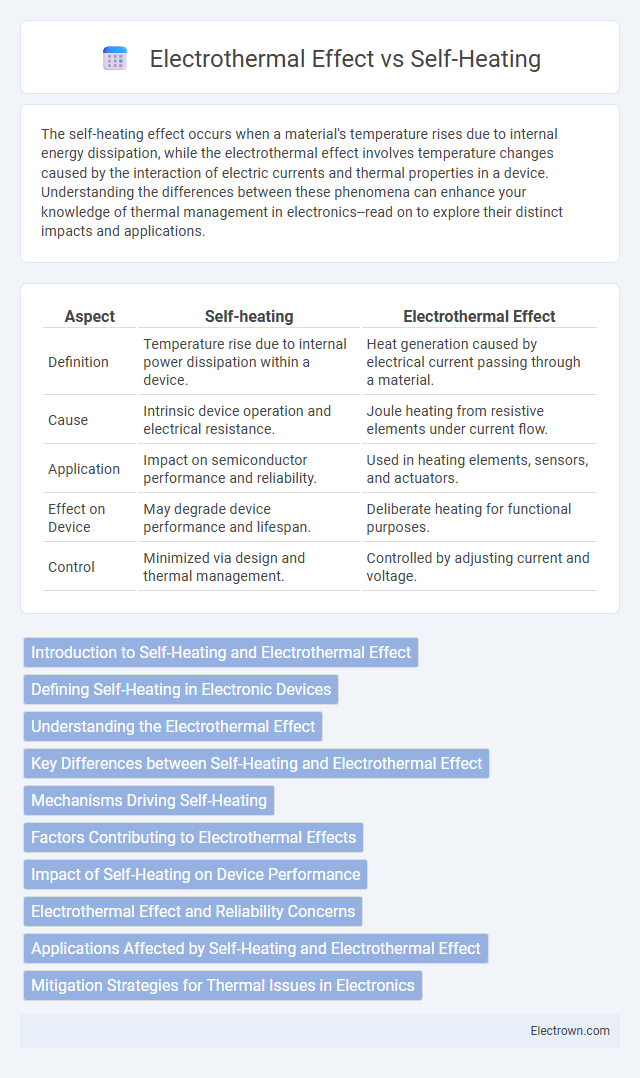The self-heating effect occurs when a material's temperature rises due to internal energy dissipation, while the electrothermal effect involves temperature changes caused by the interaction of electric currents and thermal properties in a device. Understanding the differences between these phenomena can enhance your knowledge of thermal management in electronics--read on to explore their distinct impacts and applications.
Table of Comparison
| Aspect | Self-heating | Electrothermal Effect |
|---|---|---|
| Definition | Temperature rise due to internal power dissipation within a device. | Heat generation caused by electrical current passing through a material. |
| Cause | Intrinsic device operation and electrical resistance. | Joule heating from resistive elements under current flow. |
| Application | Impact on semiconductor performance and reliability. | Used in heating elements, sensors, and actuators. |
| Effect on Device | May degrade device performance and lifespan. | Deliberate heating for functional purposes. |
| Control | Minimized via design and thermal management. | Controlled by adjusting current and voltage. |
Introduction to Self-Heating and Electrothermal Effect
Self-heating occurs when an electrical device generates heat due to internal power dissipation, raising its temperature and impacting performance. The electrothermal effect refers to the interaction between electrical currents and heat generation, where temperature changes influence the device's electrical properties. Understanding these phenomena is crucial for optimizing thermal management and reliability in semiconductor components.
Defining Self-Heating in Electronic Devices
Self-heating in electronic devices refers to the temperature rise within a component caused by power dissipation during operation, impacting performance and reliability. This phenomenon occurs due to inefficient heat dissipation, resulting in localized temperature increases that can alter electrical characteristics and accelerate device degradation. In contrast, the electrothermal effect typically involves intentional heat generation through electrical current for applications like sensors and actuators, distinguishing it from unintended self-heating impacts in semiconductor and integrated circuits.
Understanding the Electrothermal Effect
The electrothermal effect occurs when electrical energy is converted into heat within a material due to the resistance encountered by electric current flow, leading to a rise in temperature. This effect is distinct from self-heating, which often refers to unintended temperature increases caused by internal energy dissipation during device operation. Understanding the electrothermal effect is crucial for designing efficient thermal management systems in electronic components to prevent overheating and ensure optimal performance.
Key Differences between Self-Heating and Electrothermal Effect
The self-heating effect arises from the internal generation of heat within a material due to Joule heating when electric current passes through, while the electrothermal effect involves deliberate temperature changes caused by controlled electrical input to achieve specific thermal responses. Self-heating is generally an unintended consequence impacting device performance and reliability, whereas the electrothermal effect is harnessed in applications like microheaters or sensors for precise thermal management. Key differences also include the scale and purpose: self-heating is often observed at the microscopic level causing temperature rise in materials, whereas electrothermal effects are engineered for macroscale thermal control and actuation.
Mechanisms Driving Self-Heating
Self-heating primarily arises from Joule heating, where electric current passing through a material generates heat due to its resistance. The electrothermal effect, on the other hand, involves the interplay between electrical conductivity and temperature, often enhancing or modulating the material's thermal response. Understanding these mechanisms driving self-heating can help you optimize device performance and thermal management in electronic components.
Factors Contributing to Electrothermal Effects
Electrothermal effects arise primarily from the conversion of electrical energy into heat due to the resistive properties of materials, with factors such as current density, electrical resistance, and thermal conductivity playing crucial roles. The magnitude of electrothermal effects is influenced by the material's intrinsic resistivity and the geometry of conductive pathways, which affect how heat dissipates under electrical load. Your understanding of these variables helps optimize device performance by balancing heat generation and management in applications ranging from sensors to microelectronics.
Impact of Self-Heating on Device Performance
Self-heating in semiconductor devices leads to increased local temperatures, causing mobility degradation and threshold voltage shifts that negatively impact device performance. This thermal buildup accelerates reliability issues such as electromigration and time-dependent dielectric breakdown, reducing device lifespan. Contrastingly, the electrothermal effect utilizes controlled heating to improve switching speeds and reduce contact resistance, highlighting the importance of managing self-heating for optimal device operation.
Electrothermal Effect and Reliability Concerns
The electrothermal effect, characterized by localized heating due to electrical current flow in materials, plays a crucial role in the performance and reliability of electronic devices. Excessive electrothermal heating can lead to material degradation, electromigration, and thermal stress, significantly impacting device longevity and operational stability. Reliable design requires careful thermal management strategies and robust material selection to mitigate these risks and ensure consistent device performance over time.
Applications Affected by Self-Heating and Electrothermal Effect
Self-heating and electrothermal effects significantly influence the performance and reliability of semiconductor devices, especially in high-power transistors, sensors, and microelectromechanical systems (MEMS). These effects cause temperature-dependent variations in electrical characteristics, impacting applications such as RF amplifiers, power MOSFETs, and thermoelectric generators. Managing thermal behavior is critical for optimizing device efficiency, preventing thermal runaway, and ensuring long-term stability in integrated circuits and precision sensors.
Mitigation Strategies for Thermal Issues in Electronics
Mitigation strategies for thermal issues in electronics involve optimizing material properties and device architecture to reduce self-heating and manage the electrothermal effect efficiently. Techniques such as integrating high thermal conductivity substrates, employing advanced heat sinks, and utilizing pulsed power operation minimize temperature rise and improve device reliability. Thermal interface materials and dynamic thermal management algorithms further enhance heat dissipation, preventing performance degradation caused by localized overheating.
Self-heating vs electrothermal effect Infographic

 electrown.com
electrown.com